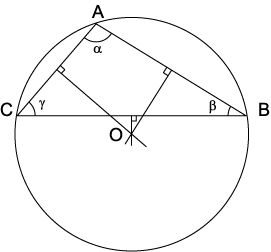Circumscribed circle
In geometry, a circumcircle of a given two-dimensional geometric shape is the smallest circle which contains the shape completely within it. Every bounded shape has a unique circumcircle. The center of this circumcirle is known as the shape's circumcenter.
Cyclic polygons
Some (but not necessarily all) vertices of the shape will lie on the circumcircle. A polygon whose vertices all lie on its circumcircle is said to be a cyclic polygon. All regular simple polygons, all triangles and all rectangles are cyclic.
Circumcircles of triangles
The circumcircle of a triangle is the unique circle on which all its three vertices lie. The circumcenter of a triangle can be found as the intersection of the three perpendicular bisectors. (A perpendicular bisector is a line that forms a right angle with one of the triangle's sides and intersects that side at its midpoint.)
A triangle is acute (all angles smaller than a right angle) iff the circumcenter lies inside the triangle; it is obtuse (has an angle bigger than a right one) iff the circumcenter lies outside, and it is a right triangle iff the circumcenter lies on one of its sides (namely on the hypotenuse). This is one form of Thales' theorem.
The diameter of the circumcircle can be computed as the length of any side of the triangle, divided by the sine of the opposite angle. (As a consequence of the law of sines, it doesn't matter which side is taken: the result will be the same.) The triangle's nine point circle has twice the diameter of the circumcircle.
The circumcenter always lies on one line with the triangle's centroid and orthocenter. This line is known as Euler's line.
See also: incircle.


